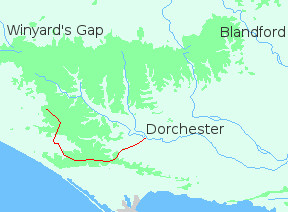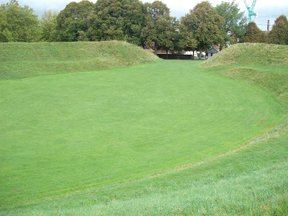
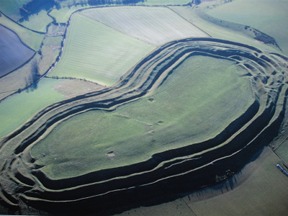
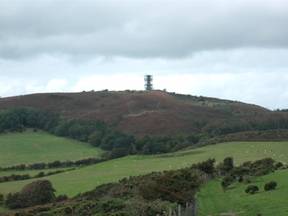
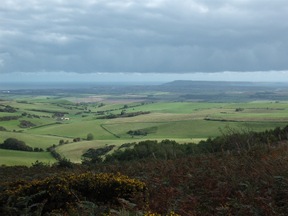
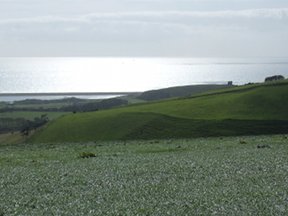
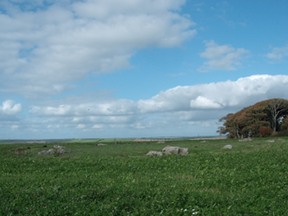
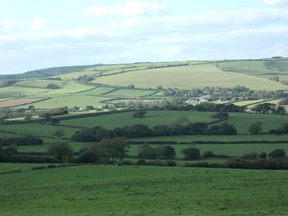
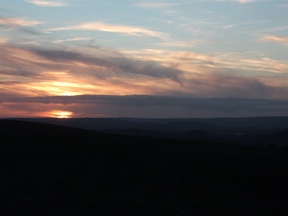
I set out from Dorchester on the long straight road to the sea. It was built by the Romans, but in the southern suburbs it passes a far older monument: Maumbury Rings, a late Neolithic henge dating from around 2500 B.C. The monument is not quite as it would have been: it was an ampitheatre in the 1st century, and a gun battery during the civil war. It still has an air of mystery, though - even more so if you can get it to yourself.
Leaving the Rings I turned off through a non-descript housing estate. After a dull half mile I came out into the countryside; and there, up ahead, I saw Maiden Castle, as the invading Romans might once have seen it. Across the level fields the ground rose sharply to a low promentory. Ramparts, dark against the sky, lay along the summit - a daunting prospect for an attacking force. But the place fell. Perhaps the defenders were spread too thinly to protect it from organized attack. Perhaps the siege engines of a professional army were too powerful. Maiden Castle fell, and Dorchester became the centre of things for the next two thousand years.
Maiden Castle is big. So big that, when you are close to it, it can be hard to get your bearings. There's an excellent aerial photo on the information board (reproduced here) - it's worth studying, if only to get some idea of the scale of the place.
From the car park I followed a slippery path, past grass-shrouded earthworks, to the tangle of banks and ditches which once guarded the western entrance. A light rain drifted down, softening the landscape. The path descended to a quiet valley, then rose steadily for the best part of a mile. At the top I turned west, along one of those airy upland ridges you find in this part of the world. To my left lay the sea, and the ever-changing bulk of Portland. Up ahead I could see Black Down, topped by the Hardy monument. And the rain eased, and the sky cleared, and all was right with the world.
Black Down is a geological oddity, an outcrop of gravel dumped on the chalk. The dark colour which gives it its name comes from the bracken, heather and gorse growing there. It was a sharp climb from the ridge, but the view from the summit was outstanding. North and west were the Dorset uplands, ridge after ridge, merging with the hazy sky. Southward the bright sea shone in the afternoon light. I traced the hills east, past Weymouth and Lulworth, and further still to Purbeck. And there, on the very edge of sight, was a white smudge: the Needles, forty miles away.
The miles after Black Down were dull. The path ran through stony fields; and for the most part it avoided the escarpment, so there were no views to enjoy. At length I came to a fold in the hills, where the land dropped dramatically to Abbotsbury. I could make out the ruin of St. Catherine's Chapel, and below it the line of Chesil Beach and the still waters of the Fleet. I turned inland, crossing a wide plateau by way of the Bronze Age stone circle on Tenants Hill. From there a shady lane descended to Litton Cheney.
There was a youth hostel marked on the map at Litton Cheney, as well as a pub. The sheet was an old one so I wasn't expecting either still to be in existence. Rural hostels are few and far between, outside the National Parks, and rural hostelries almost as rare. I was pleasantly surprised, therefore, to discover that both were still in business. It was an hour before opening time when I reached the White Horse, but there was a pleasant garden to sit in and a soothing stream of clear water.
After a solid meal I left the pub in the stillness of a September evening. The village lay in shadow, but to the north the heights were fired by the setting sun. The lane I was following climbed steeply to the main road, then off in the direction Eggardon Hill.
It's a strange feeling, being out alone in the twilight. Stand on a hill, miles from anywhere, and watch the lights spring up in the gloom. Down in the valley there is warmth and food and friendship; behind you, loneliness and the night. Darkness and isolation speak of things normally hidden: thoughts and fears which lie very deep. In confronting them we learn, just a little, who we are.
Night was falling as I neared Eggarden. There I turned aside, looking for somewhere to sleep. After a bit of a search I found a patch of grass on the edge of a field - not ideal, but reasonably secluded. As I lay on the hard ground, restless after a long day, a light mist rose and it grew colder. Far away in a distant farmhouse a dog barked.

